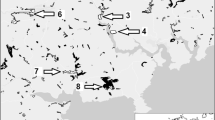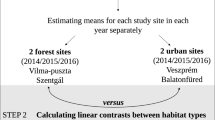Abstract
The aim of this study was to examine the effects of forest fragmentation on the ability of parent birds to provide their young with an adequate food supply. To examine whether prey population densities of the great tit (Parus major L.) and the blue tit (P. caeruleus L.) vary between study areas in different forest size classes we compared provisioning rates and chick diet and related these parameters to breeding success. We filmed 217 nests over two breeding seasons and collected data on frass fall as a general estimate of caterpillar availability. Nests which were attended by none or one parent only during filming (n = 46) were excluded from the analyses. In both years and for both species feeding rates were highest in the smallest fragments and lowest in the large forest. There was also a suggestion that differences in feeding rates between areas vary between years. We found no consistent tendency for prey size to change with forest size, although both species brought slightly smaller prey items to the nest in the smallest forest fragments and feeding rates correlated negatively with prey size. Caterpillars were the main item fed to nestlings, in both species. We found no evidence to suggest that either frass fall or the proportion of caterpillars in the diet varied with forest size. There was also no correlation between mean frass fall and the total number of caterpillars brought to the nests, in either species. Breeding success, as measured by clutch size, brood size, fledging weight and fledging success, did not differ between the small fragments and the large forest, in either species. There was also no relationship between provisioning rate (as concerns volume of prey fed to nestlings and the quality of chick diet) and breeding success parameters. In conclusion, this study does not suggest suboptimal foraging or breeding conditions in small fragments compared to a nearby large forest, for either species.
Similar content being viewed by others
Author information
Authors and Affiliations
Additional information
Received: 23 June 1997 / Accepted: 29 December 1997
Rights and permissions
About this article
Cite this article
Nour, N., Currie, D., Matthysen, E. et al. Effects of habitat fragmentation on provisioning rates, diet and breeding success in two species of tit (great tit and blue tit). Oecologia 114, 522–530 (1998). https://doi.org/10.1007/s004420050476
Issue Date:
DOI: https://doi.org/10.1007/s004420050476




